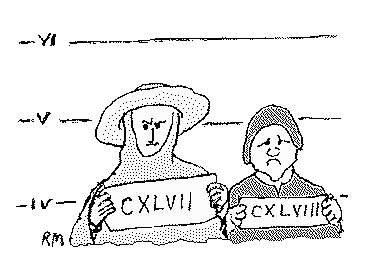
|
The Treb Files
Part 3:
|

|
The Treb Files
Part 3:
|
|
|
| Name: | Gog |
| AKA: | Number One |
| Class: | Hinged Counterweight Trebuchet |
| Size: | Throwing arm 1.65m, weight arm 0.45m, axle approx 1.2m high. |
| Power Unit: | 70 - 90 kg of scrap steel farm machinery. |
| Projectiles: | 1kg iron balls as standard, plus toilet rolls and other silliness. |
| Range: | approx 60 - 70 m with 1 kg iron balls. |
| Based upon: | The frame was inspired by a Traction treb illustration (Bibliotheque Nationale, Paris ). |
| Status: | retired, cannibalised. |
|
Gog, our first little counterweight trebuchet,
had its initial test firing session in mid-July 96 and, yes, we did
have our share of small disasters (including non-stop rain). Despite
this, the machine performed surprisingly well for a prototype effort.
Sturdily constructed with housed and nailed joints in its side panels, Gog was made to pull apart for transport. As it turned out, the only lightly constructed part of the little treb was its thin pine weight-bucket. We were about to learn our first lesson... |
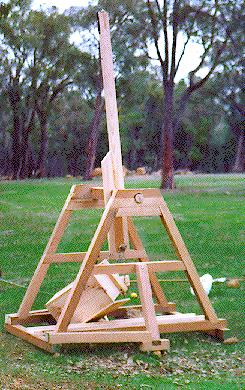
|
|
|
Arrrgggghh! Disaster! After a number of successful launches with a deliberately reduced weight in the bucket, we added just one more piece of scrap iron. The result was soon seen. In mid shot the top of one side of the timber box tore away and it, with its cargo of rusty iron, crashed into the launch trough below. The sides of the box burst open, but remarkably little damage was done to anything else. We were lucky.. |
|
| |
|
| |
|
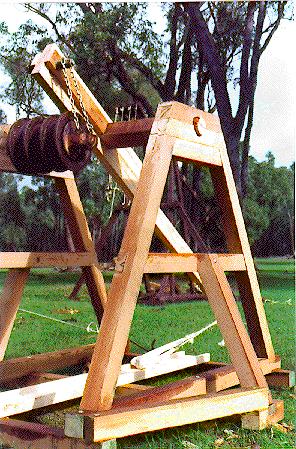
|
|
|
The
next day, and with some cannibalised farm machinery in place as an
impromptu counter-weight, the Gog was up and tossing. Here it can be
seen hurling again - the photo was taken very soon after the trigger
released the beam. (The traction trebuchet Quasimodo can be seen in the background.) |
|
| |
|
| |
|
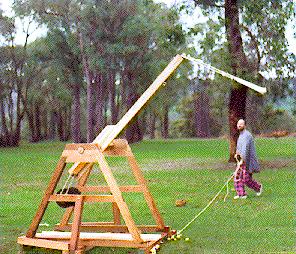
|
|
|
Here
John (the builder of the machine) looses a shot. We used a 3 metre
lanyard to pull the trigger. As with any trebuchet, the safest place to
be near a machine is off to the side. Standing behind a trebuchet is never a good idea. |
|
| |
|
|
The
ranges achieved with this little machine were modest but promising
(about 50-60 metres).. and those distances were creeping up as Gog was
used throughout the day and its bearing surfaces wore in. Gog's wooden axle had hand carved ends that sat in the holes at the top of the side frames. Heavily greased, the wood of both axle and support became smoother with every shot. |
|
| |
|
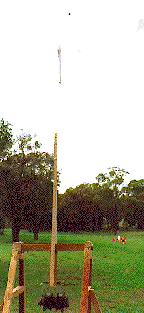
|
|
|
A metal ball projectile lobs down-range towards a cluster of old Grey Co shields. At the end of the session the shields were surrounded by impact craters, but none of them had been hit. (You have to get used to this kind of aggravation - some were so close...) Gog's long and originally unreenforced wooden axle can be seen clearly. Later the machine would have supporting pieces added to the axle/beam joint, but this one never gave any trouble. |
|
| |
|
| |
|

|
|
|
Not our most heroic projectile... A specially weighted roll of toilet paper lands with an impressive bounce, the snowy white tail following it down to fold up slowly in a loose and untidy pile. The trebuchet had launched it very steeply, but not too violently, and - except for a few metres that tore off early in the flight - the paper held together very well. (This shot from the gentle little trebuchet used up about 2/3 of the roll. Excited Tossers raced out and grabbed the now slightly soggy projectile from off the wet grass, and loaded it into the sling of the traction trebuchet Quasimodo. The considerably more vicious shot from the human-powered machine sent the roll's core twice as far - but instead of the cute tail all that was left in the projectile's path was a trail of shredded paper fragments... very messy.. ) |
|
|
|
|
|
|
|
| In accordance with Instant Ancient Tradition, our usual fun projectiles of flour bombs and fruit flew from the machine during the rest of this dramatic first day, although the best ranges came with the 900g metal ones. | |

|
|
|
This is a late photo of Gog and shows its final form. Supporting triangles of thick timber were added to the join between the axle and the beam (a permanent join on Gog) but otherwise very little modification was done. The bulldozer track wheel was still in use as a handy and dense counterweight (90kg) and hung by chains from the thick bolt that formed the counterweight axle. The launch trough, which had survived the original mishap with the collapsing weight box, continued in use and is still the trough used on Magog. The broken weight bucket was recycled - ending up as a sit-on gear box). |
|
| |
|
|
|
|
|
However, the end was nigh We had the impression that we had reached the limits of Gog's ablities. Already John was looking around for materials, not to modify the little old treb, but to build a new one based on what we had learned. This project became Magog Gog went into a quiet retirement, sitting in pieces in sheds until 2000 when it found a new life, recycled into an even bigger companion trebuchet for Magog. Gog became Frankentreb (Well, quite a few pieces of it anyway). |
|
| Last Edited: November 2000 |
|
© Russell Miners 2000. |